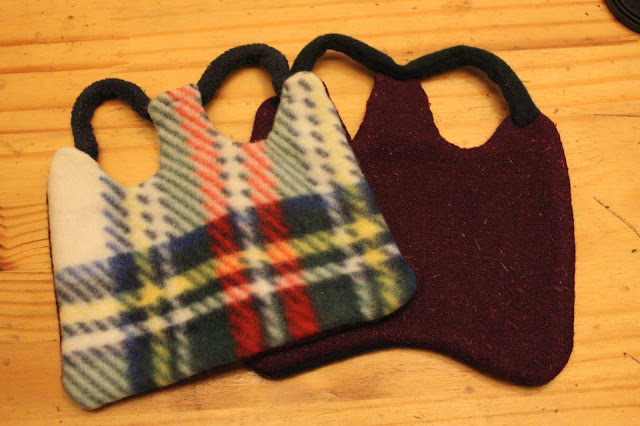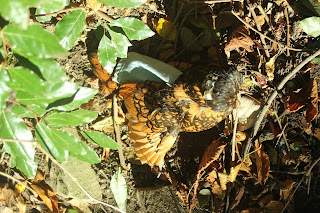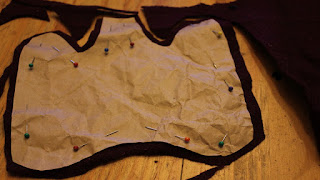Although this might seem to be some chichi fashion statement, the idea of creating a coat for your chicken, matching or not, is deadly serious. It was brought home to me some years ago that when my fine feathered breeds, such as Sebrights and Ardenners get older, particularly if they are also frizzled, they do not react well to cold weather. Older birds are very susceptible to cold stress, which if left untreated can be fatal and within twenty four hours.
How to identify birds at risk from cold stress
I have already written a piece on this and I'll put the link at the end of the article but as a general rule of thumb, any bird standing hunched on its own, who has stopped talking or preening and finally eating, is at risk. In particular I would be looking at the very old as already mentioned and very young, who within a flock will be the most likely to suffer stress from other birds and thus are doubly at risk when the weather gets colder. In writing this, I am not suggesting that flocks intentionally pick on older or younger birds but there seems to be a hierarchy-linked rite of passage birds at these ages go through. In normal weather conditions, this can be shrugged off but it is the combination of two possible stress triggers, which can push a bird over the edge into a full-blown stress attack.
Sweep above is exhibiting typical stress body language, Garboesque in its 'I vant to be alone' interpretation, so I immediately brought him inside to give him some 'time-out' and perched him on the log basket so he could get some warmth from the woodstove. Sweep is 8 years old and although recently displaced in the hierarchy, has actually formed his own coterie outside the main flock or rather as an adjunct to it. This was all going really well until the cold weather hit him.
Coat Designs and Modifications

 I based my coat on the turkey saddles, we had on our farm, they were made of strong canvas and were to protect the hen turkeys from over-amorous males. Obviously this pattern is just a starting point, each bird will need to be measured but if you start with a template along these lines and use a thick paper, then you can mould it to your chicken and work out a suitable design. When you are planning your coat consider how your bird holds its wings, i.e. in the Sebright they are rather low and also the tail is held high when on alert. Sweep liked his coat so much I left it on him on nights when it was really cold and he needed to be able to fly up to his perch/roost in it, so I took all that into consideration when I came up with my final design.
I based my coat on the turkey saddles, we had on our farm, they were made of strong canvas and were to protect the hen turkeys from over-amorous males. Obviously this pattern is just a starting point, each bird will need to be measured but if you start with a template along these lines and use a thick paper, then you can mould it to your chicken and work out a suitable design. When you are planning your coat consider how your bird holds its wings, i.e. in the Sebright they are rather low and also the tail is held high when on alert. Sweep liked his coat so much I left it on him on nights when it was really cold and he needed to be able to fly up to his perch/roost in it, so I took all that into consideration when I came up with my final design.
I also used a double fabric for extra warmth. For Sweep, who likes going out in all weathers this was wool and fleece, which has some degree of waterproofing being made of recycled plastic bottles. The plaid fleece fabric was from a car blanket I'd used to make a jacket for Andy, so there was just enough in remnants to make one for Sweep. The second coat was made for Sweep's nephew Squarky, who hates damp weather, so had a double wool fabric, as you can see the design was made-to-measure for each bird. This pattern can also be used to make chicken saddles for your hens, should they begin losing feathers due to similar problems to those of our hen turkeys.
 Today, on the first day of November, the outside temperature was 21°C or 70°F and although we live in a micro-climate on the North Western coast of France this is still pretty unusual. It should be mentioned that sudden changes in weather can also trigger stress in vulnerable birds. I wanted my Polish hen Bungle to model a home-made chicken saddle but even though in fine denim it was too much like hard work when added to her Winter plumage. She immediately flopped down for a sunbathe.
Today, on the first day of November, the outside temperature was 21°C or 70°F and although we live in a micro-climate on the North Western coast of France this is still pretty unusual. It should be mentioned that sudden changes in weather can also trigger stress in vulnerable birds. I wanted my Polish hen Bungle to model a home-made chicken saddle but even though in fine denim it was too much like hard work when added to her Winter plumage. She immediately flopped down for a sunbathe.Update: Spring Collection 2016 It has to be denim. I just noticed this little Frizzle has had her feathers damaged by a cockerel, so she is out and about in her new denim coat.
Fabrication
Pin the pattern to the fabric and cut out, including a seam allowance. Repeat the process with another piece of fabric.
With right sides together, sew along the seam allowance, leaving an opening at the neck. Use this to turn the fabric. Then fold in the seams of the opening, sew together and press with a warm iron.
To make the wing loops, cut a piece of fleece, with some stretching ability or use elastic. You will need to plan this so the coat fits snugly to the back but allows the wings to slip easily through the loops. If you use my proportions in the photographs, these work very well.
 Cut the piece of fleece for the loop from enough fabric
so you can make a cylinder, this way you can stop any potential for the
fabric to fray.
Cut the piece of fleece for the loop from enough fabric
so you can make a cylinder, this way you can stop any potential for the
fabric to fray. Sew the piece of fleece to make the wing loops as per photograph.
If it is too loose the bird will easily remove the coat, by accident and if too tight it will be uncomfortable and restrict movement.
In the following film I go through the whole process in detail, plus there are tips on putting on and taking off the coat. However, after the first couple of times, I found my birds would actually help me do this.
This coat made such a difference to the quality of life of both these birds in the Winter months. Instead of huddling unhappily in a corner, they were happy to be out foraging even on the coldest days.
Thanks for dropping by and do feel free to share experiences or ask for further information in the comment section. If you have enjoyed this piece and found it useful think about sharing it with your family and friends, on social media and also maybe about joining this blog and/or subscribing to my Youtube channel or even supporting us on Patreon or
It all helps to keep me going!
All the very best,
Sue
RETURN TO CONTENTS PAGE
© Sue Cross 2015
RELATED ARTICLES
 STRESS - When? Why? Whom? Identification, causes and those most at risk
STRESS - When? Why? Whom? Identification, causes and those most at risk
Stress comes for all sorts of reasons to an organic flock and if not treated within 24 hours, if it's a bad attack, it can be fatal...read more
 STRESS-Emergency Treatment, Follow-ups and Keeping Calm
STRESS-Emergency Treatment, Follow-ups and Keeping Calm
The great thing about this emergency treatment is that it is concocted from simple foodstuffs you probably already have to hand in your kitchen cupboards...read more














Wow, what a great idea and so much labor put into it to save your birds and make them comfortable. My Mom was raised on a farm and tells a story of how some of their chickens froze and they brought them in the house to warm them up and they came alive....I always wondered if this story was just a tall tale?
ReplyDeleteCarol
Hi Carol, How nice of you to take time out to comment, I appreciate it. Well my birds give me a lot and they deserve my time and best efforts. Your Mom is totally correct. Birds 'close down' when they get cold, in particular baby birds and amongst them, pigeons in my experience are the most dramatic. If you saw them you would think they were dead. You can see no movement, no breathing nothing but..if you get them near a heat source as soon as you find them in this state you can get them right back and with absolutely no physical damage nor to the nervous system. It is amazing. I often try to remember to get the camera out when this happens but normally I am too busy getting the bird back to life. I heat them on or even in, the wood stove if it is not too hot and years ago,when I owned one, I would use a hair dryer. You just have to be careful to keep an even temperature and I always put my hand in front of them to make sure they are not getting burned rather than heated. It is a lovely moment when you see the toes begin to twitch and the bird comes essentially back to life, you need to carry on heating until they begin to 'talk' or if they are old enough, to open their eyes. Then I get them back under their mother. This usually happens in Fall when we get sunny days and the parent pigeons both go looking for food rather than leave one sitting the chick on the nest. I have also heated up a pigeon under a broody hen, that works well too. So the moral is, never imagine a bird is dead just because it looks like it is! All the very best from Normandy, Sue
DeleteP.S. I made film costumes last year for a small independent film company and I used your method for creating fabric flowers for two of the dresses, I'll give you a credit and the link when I write it up on my refashioning blog.
Hello good day! congratulation in all your frizzle pets.
ReplyDeleteI have a lot questions. I been sending emails or comments to different ppl. from almost a months and not have anyone to answer me.
well at difference of you I live in the Caribbean. Is very very hot here.
Any way I adopted 2 of this beauty chicks unfortunate they are sick w the flu.. and the other one have a breathing problem only when she scare.. It is no all the time.
Here I can found any of Vet to tell me to much about it...
Well the only I know for the previous owner or farmer .. all his chicken escape and the was under the rain ...
Like you know they can't be wealth for to long..
Any way do you have or know any recommendation about what to do...???
I giving pieces or garlic but she still have i imagine the infection on her throw.
If you contact me i will sending the photos
he say one is around 6 months and the other one is small 4 months.
they are so cute.
Plus i have other chicken and baies chicks ..
Plus i can put yet together until this hens are better.
Please email me at goldfish120110@hotmail.com
Mrs Herzi
Hi there, I am so sorry I only just found your comment! Blogger has completely altered the way the site functions and we no longer get alerted when people comment. Any way I can give you some pointers for your problems. The first one being that with chickens that are kept outside and have good food, in my experience respiratory problems are linked to stress. This is not always something obvious, such as predator attacks because extremes in weather, too hot, too cold or weather that changes frequently can cause stress. One of the pointers of stress is frequent sneezing. I've had chickens sneeze and be stressed just by being transported in a car. If you think about it, buying a chicken and taking it from one environment to another, is very stressful just as with humans, moving house can be the most stressful experience in their life. When the body is under stress it created toxins, these poisons need to be expelled 'detoxed' and one of the most common ways is through the nose, hence coryza and sneezing in chickens. I have a whole raft of articles on stress on this blog and also a new article on respiratory problems and how to use steam-inhalations to help with the detox: stic-hen.blogspot.com/2018/08/treating-roupcoryza-upper-respiratory.html#.XoXC2ncv6V4 This is the link for Part 1 and you will find the link for Part 2 at the end of it. That said you could have an underlying problem due to th chickens getting wet and thus coming down with an illness but by feeding them with the suggested nutrition i.e. keep them off grain and feed them natural invertebrate food, you can do a lot to cure and prevent it reoccurring. Hope this helps and all the very best from France, Sue
Delete